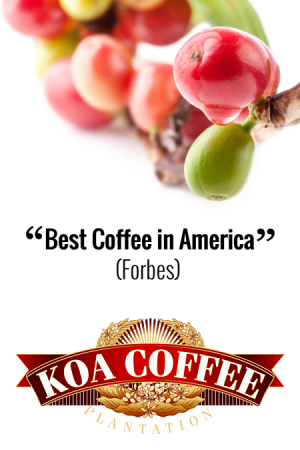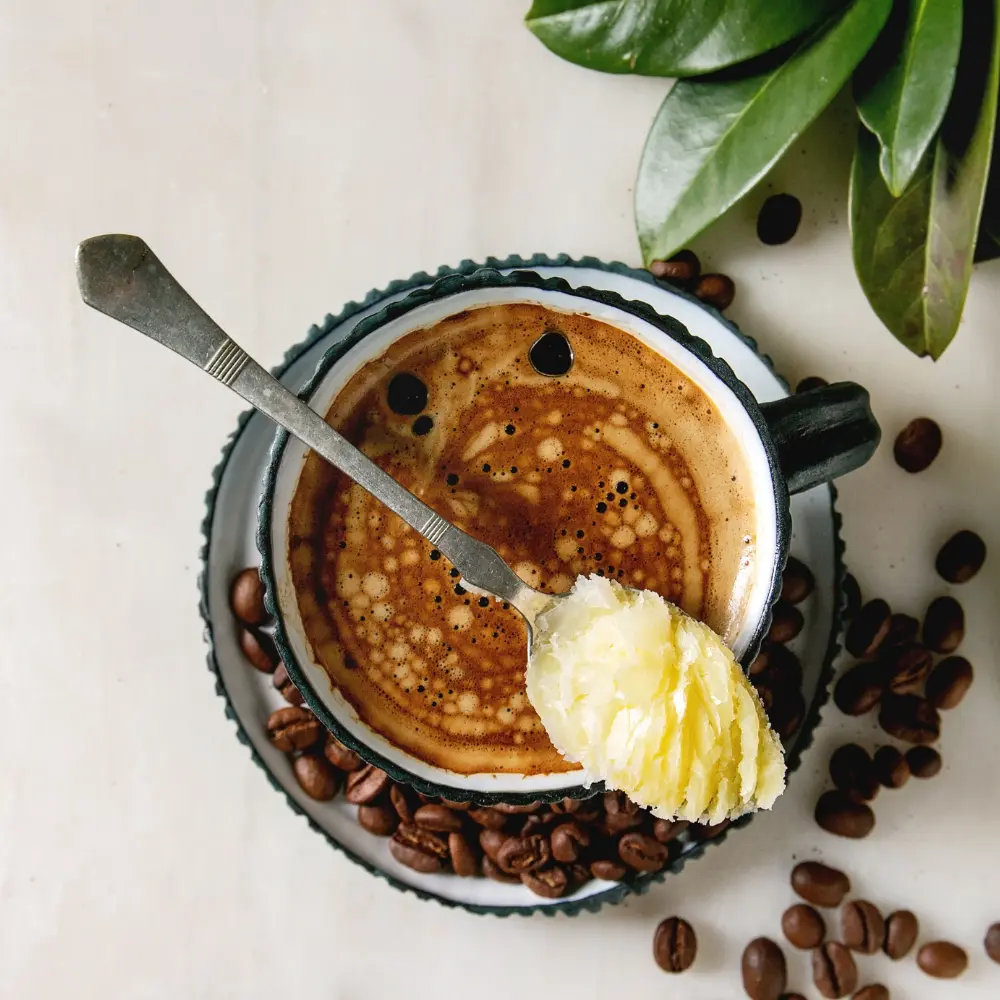The modern era, where expedience frequently usurps tradition, has penetrated even the domain of coffee. Freeze-dried coffee, an increasingly fashionable product amongst coffee connoisseurs and those with bustling lifestyles, exemplifies this inclination. But what is freeze-dried coffee, and how does it measure up against conventionally brewed coffee concerning its caliber, flavor, and sustainability?
Behold the Ultimate Guide to Freeze-Dried Coffee: Quality, Flavor, and Sustainability. In this all-inclusive expedition, we shall undertake a thorough examination of the world of freeze-dried coffee, leading you on an odyssey from its spellbinding history and the progression of the freeze-drying technique to its impact on the environment and the coffee industry at large. Along the way, we shall scrutinize the elements that contribute to the taste and quality of freeze-dried coffee and impart pragmatic pointers on selecting the most optimal brands and products. Lastly, we shall unveil some innovative methods of indulging in this adaptable and convenient coffee substitute in your daily life.
Therefore, whether you are an inquisitive coffee aficionado wishing to broaden your horizons or a seasoned freeze-dried coffee enthusiast seeking expert discernment and commendations, this guide is the quintessential reference to satiate your thirst for knowledge. Seize your favorite mug, and let us embark on this invigorating escapade together.
Freeze Dried Coffee: Key Takeaway
- Freeze-dried coffee offers a convenient, portable alternative to traditional coffee brewing methods, with a long shelf life and minimal impact on flavor quality when produced correctly.
- The freeze-drying process differs significantly from other instant coffee production methods, such as spray drying, resulting in unique texture and flavor profiles.
- Sustainability is an important consideration in this coffee industry, with factors like carbon footprint, energy consumption, and packaging play key roles in determining the environmental impact.
- Choosing the best coffee brand involves evaluating factors such as flavor, quality, sustainability, price, and reviews or recommendations from others.
- This coffee can be enjoyed in a variety of ways, from simple hot or cold beverages to creative recipes, and as a convenient option for travel and outdoor adventures.
The History and Evolution of Freeze Dried Coffee
Understanding the journey of this instant coffee helps us appreciate the hard work and innovation that went into creating this convenient and flavorful coffee option. Let’s take a look at the origins of freeze drying technology, the commercialization of freeze-dried coffee, and how it has risen in popularity over the years.
The Origins of Freeze Drying Technology
Freeze drying, or lyophilization, is a dehydration process that has its roots in the ancient Incan Empire. However, it wasn’t until the 19th century that modern freeze drying technology began to take shape. In 1906, French scientists Arsène d’Arsonval and Frédéric Bordas were the innovators responsible for the development of the freeze-drying process. Yet, it wasn’t until 1943 that this technique was formally given its name, “freeze-drying”, by the renowned Professor Alexander Fleming. (1)
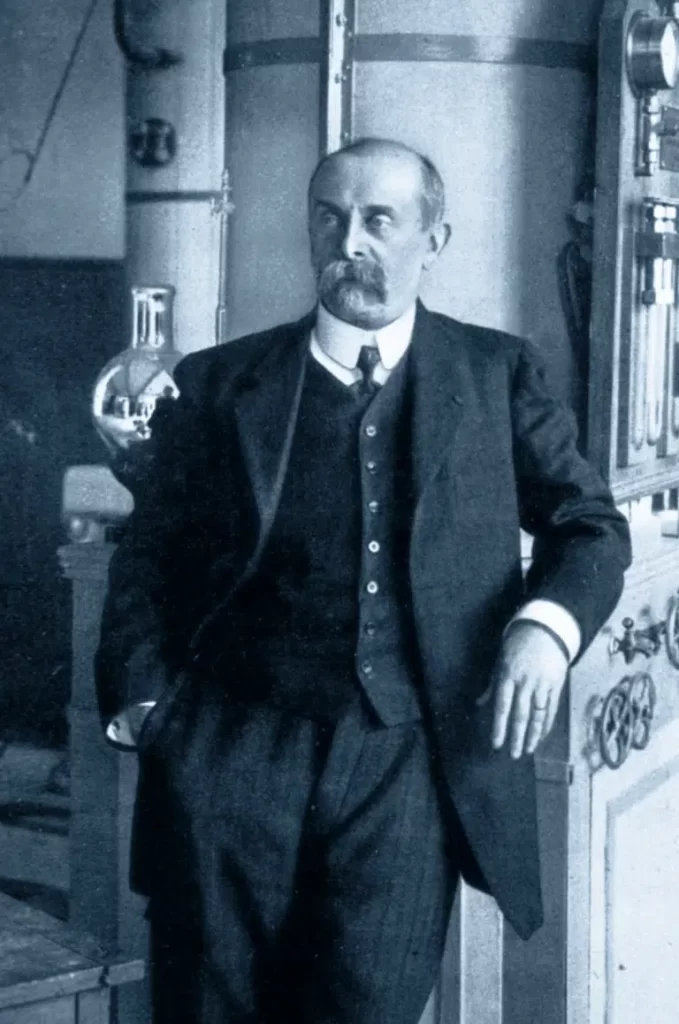
During World War II, freeze drying emerged as an essential method for preserving blood plasma and penicillin, which required stable storage and transport conditions. The success of these applications led to further development and exploration of freeze drying for various industries, including the food sector.
The Commercialization of Freeze Dried Coffee
The commercialization of this coffee can be traced back to the 20th century when companies started looking for ways to simplify coffee preparation, reduce weight and volume, and extend shelf life. In 1938, Nestlé introduced Nescafé, the first instant coffee, which was made using a spray drying technique. Although instant coffee became popular, its flavor couldn’t match that of traditionally brewed coffee.
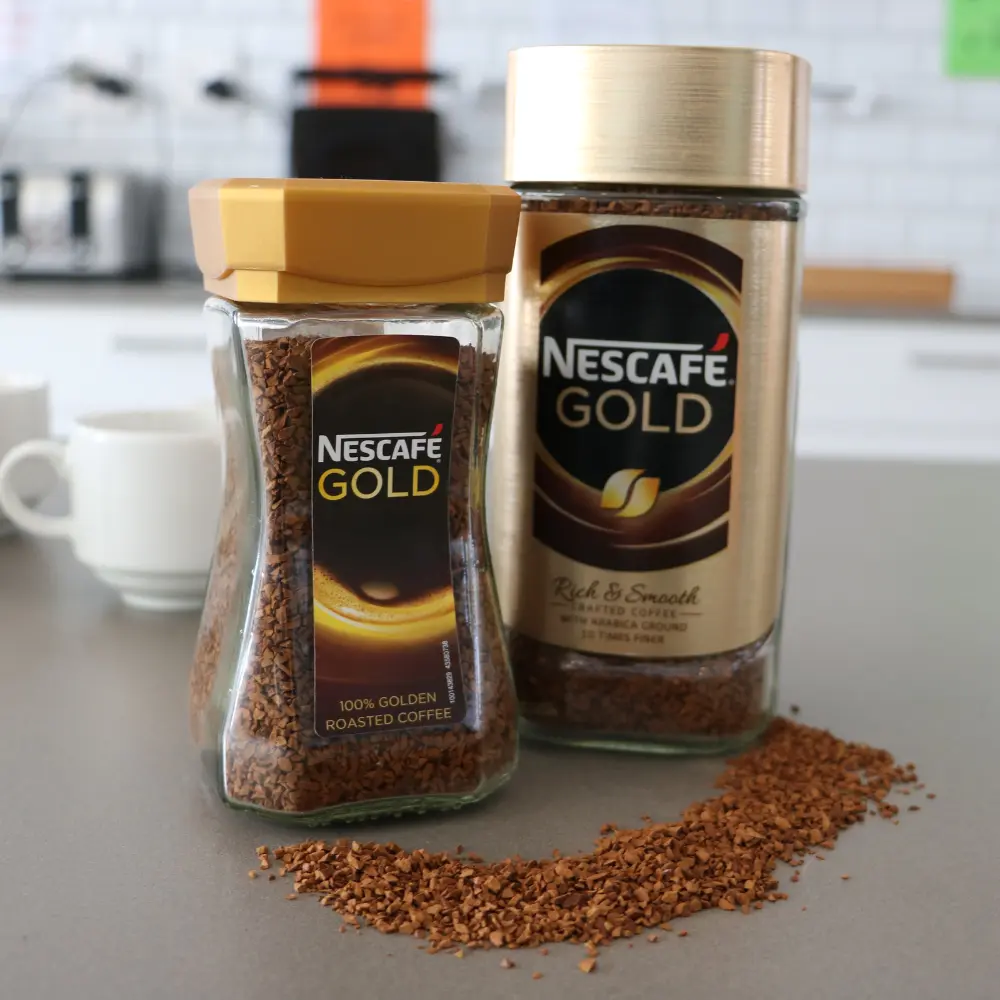
This quest for a better-tasting instant coffee led to the development of this coffee. Freeze drying allowed manufacturers to preserve more of the coffee’s original flavor and aroma, providing a more enjoyable experience for consumers. This method involves freezing the brewed coffee and then placing it in a vacuum chamber, where the ice is converted directly into vapor, leaving behind a dehydrated coffee granule.
The Rise in Popularity and Technological Advancements
The unique qualities of this instant coffee—convenience, consistency, and an ever-improving flavor—made it a popular choice among consumers. The increasing demand led to continuous research and development aimed at perfecting the freeze drying process and enhancing the final product’s taste and aroma.
In recent years, technological advancements in the freeze-drying process have resulted in even better flavor retention and a more satisfying coffee experience. Modern equipment, improved processing techniques, and a deeper understanding of coffee bean chemistry have all contributed to the refinement of this coffee.
Today, this beverage is not only popular among busy individuals seeking a quick and convenient coffee fix but also among outdoor enthusiasts, travelers, and even astronauts. Its lightweight, easy-to-prepare nature and extended shelf life make it an ideal choice for those constantly on the go. As technology continues to advance, we can expect further improvements in the quality and flavor of this instant coffee, ensuring its place in the ever-evolving world of coffee culture.
The Freeze Drying Process and Its Impact on Flavor
One of the most critical facets that distinguish freeze-dried coffee from other coffee items is the exclusive method employed to produce it. The freeze-drying process is instrumental in determining the taste, fragrance, and comprehensive quality of the ultimate product. In this segment, we shall scrutinize the intricate details of the freeze drying technique, examine its effect on the coffee’s flavor profile, and draw a comparison with traditional brewing methods.
An Overview of the Freeze Drying Method
The freeze-drying process commences with brewed coffee, typically made from premium-grade beans carefully chosen and roasted to highlight their optimal flavor. Once brewed, the coffee is rapidly frozen at exceptionally low temperatures, usually around -40°F (-40°C). This expeditious freezing process aids in preserving the coffee’s flavor and aroma compounds.
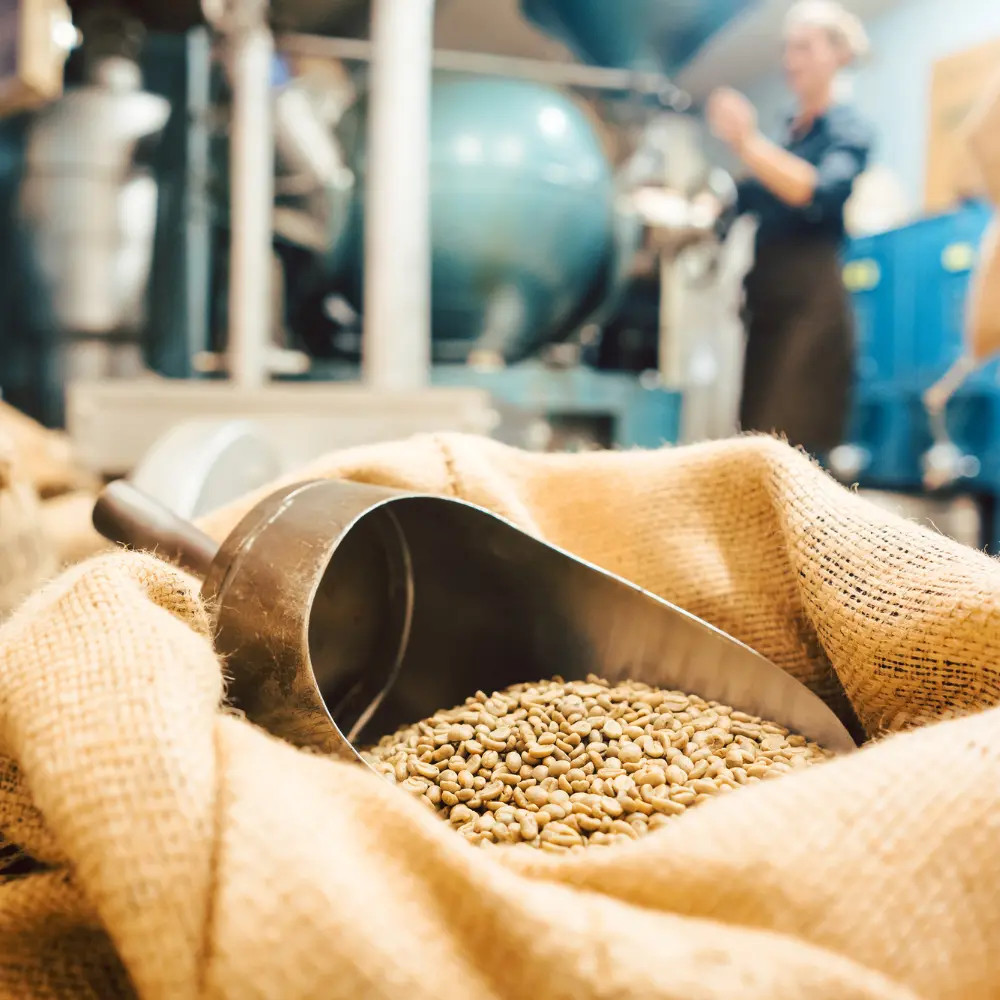
Following that, the frozen coffee is placed in a vacuum chamber where the pressure is significantly diminished. Under these conditions, the ice in the coffee undergoes sublimation, implying that it changes directly from a solid state to a gaseous state without passing through the liquid phase. This operation extracts the moisture from the coffee while minimizing the loss of flavor and aroma compounds.
The resulting freeze-dried coffee granules are subsequently ensconced in hermetic containers or vacuum-sealed bags to protect them from oxygen and moisture, ensuring that the coffee retains its freshness and flavor for an extended duration.
How Freeze Drying Affects Coffee Flavor Profile
The impact of freeze drying on the coffee’s flavor profile is noteworthy. Compared to other preservation techniques like spray drying, freeze drying is more adept at retaining the original taste and aroma of the coffee. (2) This is because the process circumvents the use of high temperatures, which can degrade the delicate flavor and aroma compounds present in the coffee.
Nevertheless, it is vital to note that this type of coffee may still manifest some disparities in flavor compared to freshly brewed coffee. The process of freezing and sublimation has the potential to modify the equilibrium of compounds responsible for coffee’s taste and aroma, possibly resulting in subtle changes in the coffee’s flavor profile.
Comparing Freeze Dried Coffee to Traditional Brewing Techniques
In terms of comparing this instant coffee to conventionally brewed coffee, the differences in taste, aroma, and general quality primarily rely on personal preferences. Freshly brewed coffee, whether produced through a drip coffee maker, French press or espresso machine, typically furnishes a more intricate and nuanced flavor profile. This is because freshly ground coffee beans discharge their volatile compounds at the time of brewing, culminating in a richer, more aromatic cup of coffee.
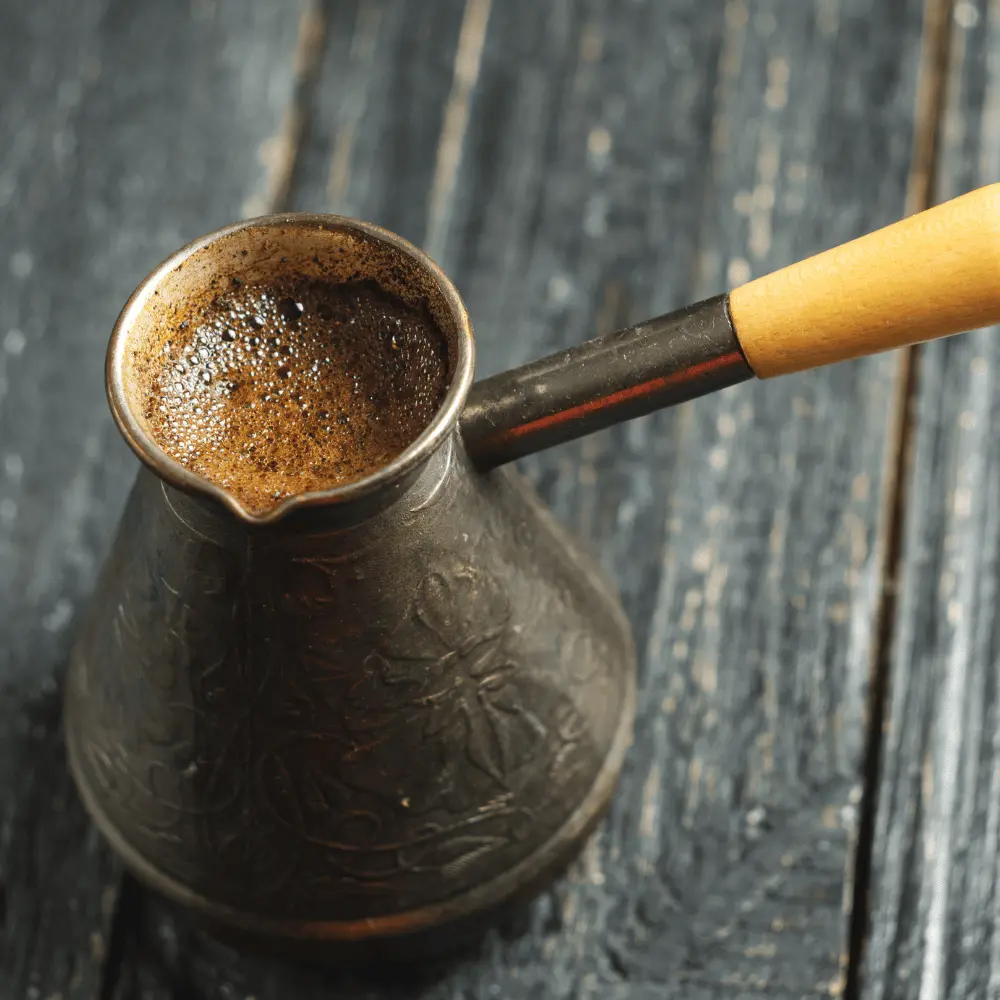
Conversely, this instant coffee offers a degree of convenience and consistency that is arduous to accomplish with traditional brewing techniques. Although the flavor profile of this coffee may not be as intricate as that of freshly brewed coffee, innovations in the freeze drying process have led to substantial advancements in the taste and aroma of these products. As a consequence, freeze-dried coffee has emerged as a favored option for those seeking a hassle-free and enjoyable coffee experience devoid of the exigencies and equipment necessitated by traditional brewing methods.
When comparing this type of coffee to traditional brewing techniques, it is vital to consider the pros and cons of each method. While individual inclinations will ultimately determine the best choice, comprehending the advantages and disadvantages can aid in making an informed decision.
Pros of Freeze Dried Instant Coffee:
- Convenience: this instant coffee is swift and straightforward to prepare, requiring solely hot water and a cup. This renders it ideal for busy mornings or when you’re on the go.
- Consistency: Given that this type of coffee is pre-brewed, you can anticipate a consistent flavor with every cup, irrespective of external factors like brewing time, water temperature, or coffee grind size.
- Portability: The lightweight and compact nature of this coffee make it an excellent option for traveling, camping, or hiking, as it occupies minimal space and doesn’t necessitate specialized equipment.
- Shelf life: Owing to its low moisture content and hermetic packaging, this type of coffee boasts an elongated shelf life, permitting you to relish a cup even if you haven’t procured fresh coffee beans in a while.
- Versatility: This instant coffee can be utilized in a diverse array of recipes, from baking to cooking, imparting a unique flavor profile to your preferred dishes.
Cons of Freeze Dried Instant Coffee:
- Flavor complexity: Although the freeze drying process has evolved over time, this coffee may not deliver the same complexity and depth of flavor as freshly brewed coffee produced using traditional methods.
- Cost: High-quality freeze dried instant coffee may be more expensive than traditional coffee beans or grounds, particularly when considering the price per cup.
- Environmental impact: Packaging for this instant coffee frequently involves single-use plastics, which may contribute to environmental concerns. Nonetheless, some brands are working towards more sustainable packaging alternatives.
- Limited customization: With this type of coffee, you have limited control over the brewing process and variables such as water temperature and coffee-to-water ratio, which may impede your ability to tailor your coffee experience to your specific taste preferences.
- Lack of freshness: Despite its prolonged shelf life compared to traditional coffee, this instant coffee cannot compete with the freshness of coffee beans or grounds that have undergone recent roasting and brewing.
Comparing Freeze Dried Coffee to Spray-Dried Coffee
Even though both freeze dried and spray-dried coffee belong to the instant coffee category, they are generated using distinct techniques, which can exert a significant influence on their flavor, aroma, and comprehensive quality. In this section, we shall compare this instant coffee to its spray-dried counterpart, highlighting the principal differences between the two methods.
Production Process
This type of coffee, as mentioned before, is produced by swiftly freezing brewed coffee and then depositing it in a vacuum chamber, where the ice is transformed directly into vapor, leaving behind dehydrated coffee granules. This process preserves more of the coffee’s original flavor and aroma compounds, as it avoids exposure to high temperatures.
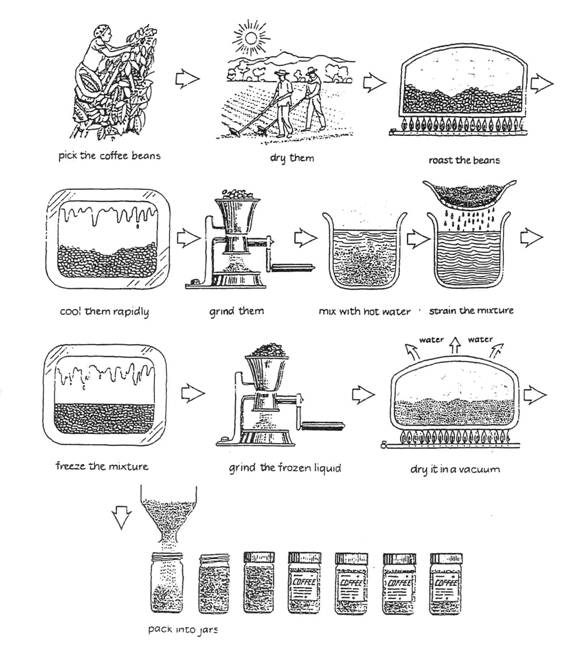
Spray-dried coffee, in contrast, is concocted by showering brewed coffee into a hot chamber, where the water vaporizes expeditiously, generating fine coffee powder. The process is swifter and more cost-effective than freeze drying but exposes the coffee to higher temperatures, which can result in the deterioration of delicate flavor and aroma compounds.
Flavor and Aroma
This coffee usually boasts a more potent and intricate flavor profile in comparison to spray-dried coffee, as it conserves more of the original taste and aroma compounds. The lower temperatures employed during the freeze drying process aid in preserving the fragile compounds responsible for coffee’s unique attributes.

Conversely, spray-dried coffee tends to possess a more subdued flavor and aroma, as the high temperatures employed during production can lead to the loss of some volatile compounds. This may lead to a less multifaceted taste and a less gratifying coffee experience for some consumers.
Texture and Solubility
This instant coffee typically possesses a granular texture that dissolves swiftly and effortlessly in hot water. This can result in a silkier, more uniform cup of coffee with a pleasant mouthfeel.

Spray-dried coffee, owing to its fine powder form, may not dissolve as readily, potentially resulting in a less consistent texture or even clumps in the final cup. Nonetheless, some individuals may prefer the finer texture of spray-dried coffee, particularly when utilized as an ingredient in recipes or blended with other beverages.
Cost and Availability
Spray-dried coffee is typically less expensive than freeze dried coffee, as the production process is swifter and more cost-effective. This renders it more widely available and accessible to consumers.
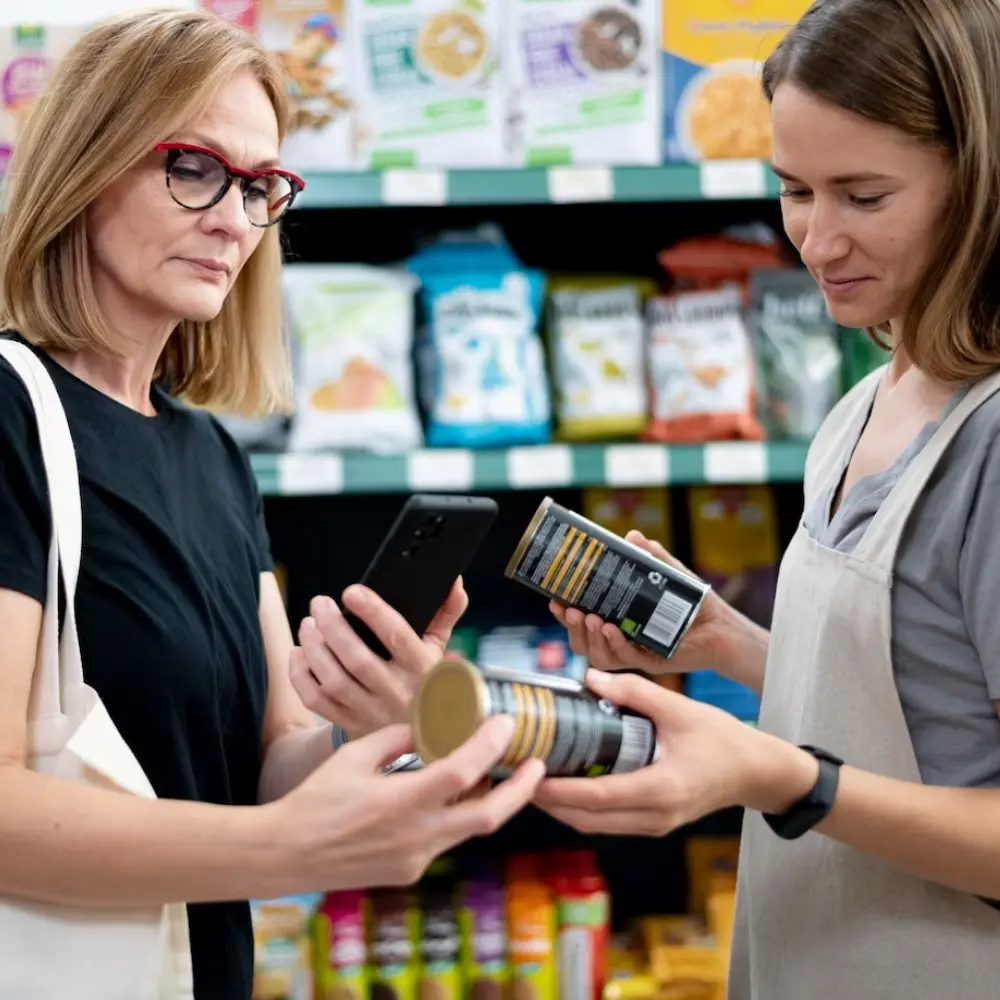
This coffee, though frequently more expensive, is frequently favored by those seeking a higher-quality instant coffee alternative. The price discrepancy is often warranted by its superior flavor and aroma in comparison to its spray-dried counterpart.
In summary, the preference between freeze dried and spray-dried coffee mainly relies on individual preferences, priorities, and budget. While this instant coffee generally provides a more satisfying flavor and aroma, spray-dried coffee offers a more economical and broadly accessible option for those seeking convenience and cost-effectiveness.
Sustainability and Environmental Impacts of Freeze Dried Coffee
As consumers grow increasingly aware of the environmental impact of their choices, it’s crucial to consider the sustainability of this instant coffee. In this section, we shall explore the carbon footprint of coffee production, compare the energy consumption of freeze drying to traditional methods, and discuss waste reduction and packaging considerations.
The Carbon Footprint of Coffee Production
Coffee production possesses a significant carbon footprint, with factors such as farming practices, transportation, and processing contributing to greenhouse gas emissions. The cultivation process itself can result in deforestation, as land is cleared for coffee plantations, and the use of chemical fertilizers and pesticides can exert adverse environmental effects. (3)
This coffee’s production supplements another layer of complexity to the carbon footprint calculation. The energy-intensive freeze drying process can escalate the overall greenhouse gas emissions related to coffee production. However, it’s critical to note that the prolonged shelf life of this coffee can aid in offsetting some of these emissions by reducing waste from spoiled or stale coffee.
Energy Consumption of Freeze Drying
The freeze drying process can consume a substantial amount of energy, particularly during the sublimation stage, where the coffee is dehydrated. However, advancements in technology and equipment have led to improvements in the energy efficiency of freeze drying machines.
When compared to traditional brewing methods, the energy consumption of freeze drying is higher due to the specialized equipment and technology required. Nonetheless, the lower waste and longer shelf life of this instant coffee can help offset some of these energy costs over time. Additionally, some manufacturers have implemented renewable energy sources and sustainable practices in their production processes to reduce their environmental impact.
Waste Reduction and Packaging Considerations
One advantage of this coffee is its long shelf life, which can reduce waste by preventing the need for frequent replacements of stale or expired coffee. Additionally, the lightweight and compact nature of this instant coffee makes it easy to transport, reducing the carbon emissions associated with transportation.
However, the packaging often involves single-use plastics, which can contribute to environmental concerns. Some manufacturers are working towards more sustainable packaging options, such as biodegradable materials or reusable containers, to reduce their environmental impact. Consumers can also make a difference by choosing brands with sustainable packaging and properly recycling their coffee containers.
Choosing the Best Freeze Dried Coffee Brands and Products
With the growing popularity of this coffee, consumers have more options than ever before when it comes to selecting a brand or product. In this section, we’ll discuss the factors to consider when choosing a brand and introduce some top brands to try and highlight innovative products and trends in the market.
Factors to Consider When Selecting a Brand
When selecting a freeze dried coffee brand, it’s essential to consider several factors, such as flavor, quality, sustainability, and price. Here are some aspects to keep in mind:
- Flavor profile: Look for a brand that offers a flavor profile that suits your taste preferences, whether you prefer a bold, dark roast or a lighter, more nuanced flavor.
- Quality: Opt for a brand that uses high-quality beans and prioritizes the freeze drying process to ensure the best possible taste and aroma.
- Sustainability: Seek out brands that prioritize eco-friendly practices, such as sourcing beans from sustainable and ethical farms, using energy-efficient freeze drying methods, or offering recyclable or biodegradable packaging.
- Price: While higher-quality coffee may come at a higher price, consider the value you’re getting for your money, and find a brand that aligns with your budget.
- Reviews and recommendations: Consult online reviews or seek recommendations from friends, family, or coffee enthusiasts to help narrow down your choices.
Top Freeze Dried Coffee Brands to Try
While there are numerous freeze dried coffee brands available, some have gained a reputation for their exceptional quality, flavor, and sustainability efforts. Here are a few brands to consider trying:
Alpine Start

A popular choice among outdoor enthusiasts, Alpine Start offers a range of options, including original blend, coconut creamer latte, and dirty chai latte.
Waka Coffee
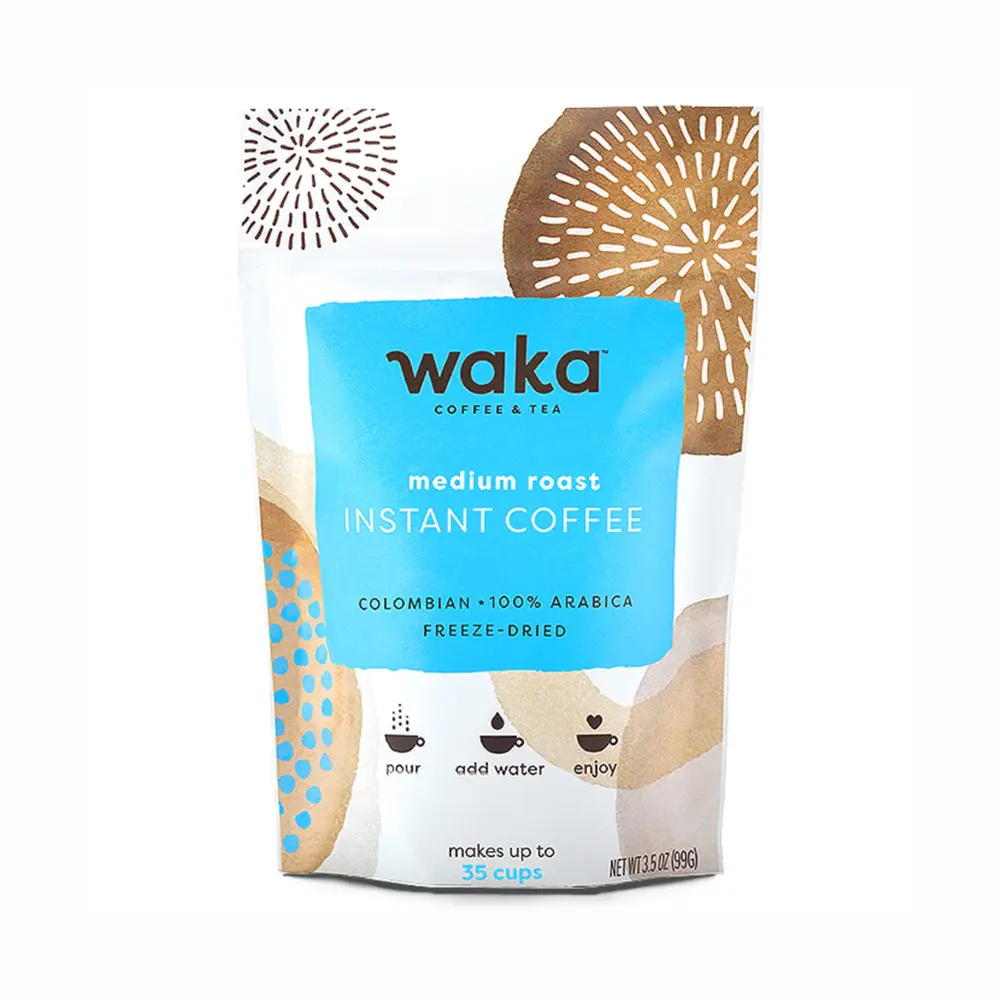
With a focus on sustainability and social impact, Waka Coffee sources high-quality beans and donates a portion of its profits to clean water initiatives.
Mount Hagen
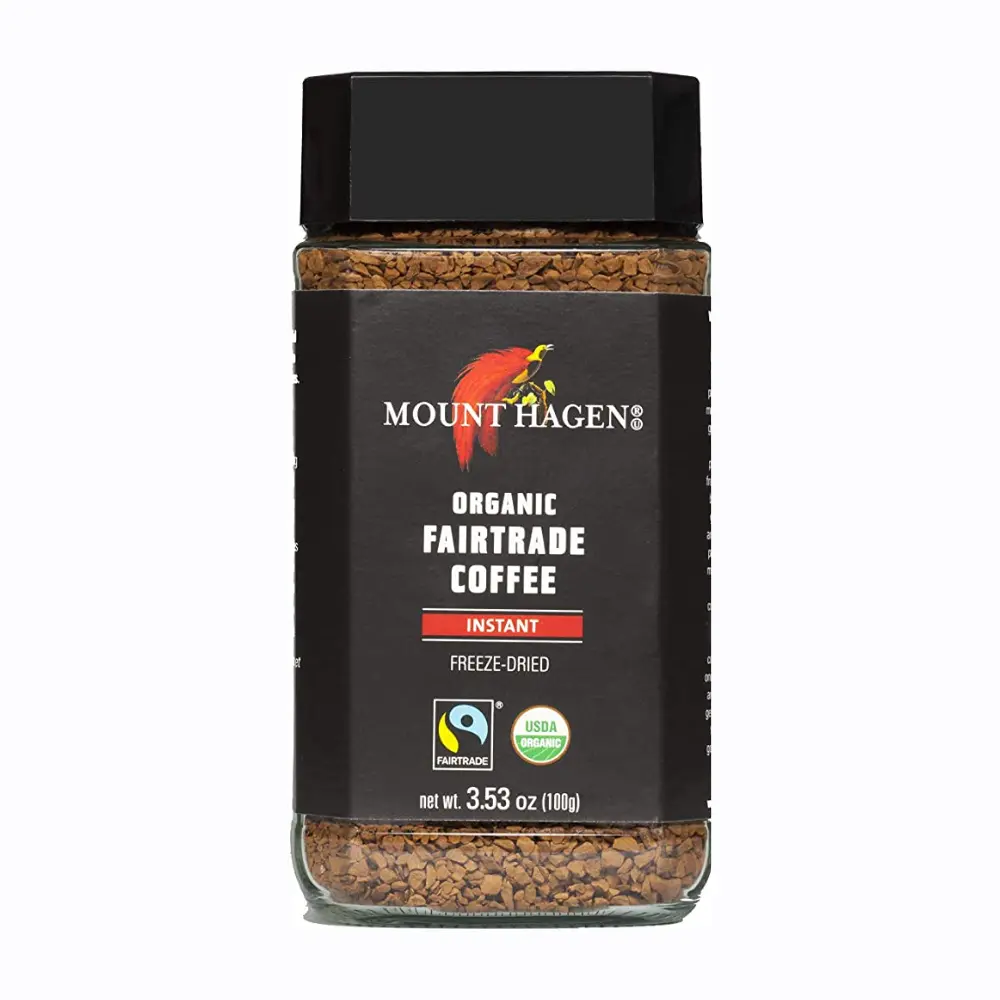
As one of the pioneers in the organic coffee industry, Mount Hagen offers a range of organic, fair-trade coffee products with rich and complex flavors.
Innovative Products and Trends in the Freeze Dried Coffee Market
As the coffee market continues to grow, brands are introducing innovative products and trends to cater to the evolving tastes and preferences of consumers. Some notable developments include:
- Specialty coffee offerings: Brands are increasingly focusing on sourcing high-quality, single-origin beans to create coffee products that appeal to specialty coffee enthusiasts.
- Flavor innovations: Freeze-dried coffee brands are expanding their product lines to include unique flavors and blends, such as flavored lattes, mochas, and even cold brew options.
- Sustainable packaging: In response to environmental concerns, some brands are introducing more eco-friendly packaging solutions, such as compostable or recyclable materials.
- Functional ingredients: To cater to health-conscious consumers, some freeze-dried coffee products now include functional ingredients like adaptogens, vitamins, or plant-based creamers.
By considering factors such as flavor, quality, sustainability, and price, you can select a brand that meets your preferences and needs. As the market continues to evolve, keep an eye out for innovative products and trends that enhance the coffee experience.
Tips and Tricks for Enjoying Freeze Dried Coffee
For those who hold both a penchant for the daily dose of coffee and the ease of handling, this instant coffee stands as a convenient and versatile option. This article divulges some essential tips and tricks to optimally prepare and store this coffee, explores ingenious recipes and ideas for utilizing it, and discusses how to relish this beverage during travels and outdoor escapades.
How to Properly Prepare and Store Freeze Dried Coffee
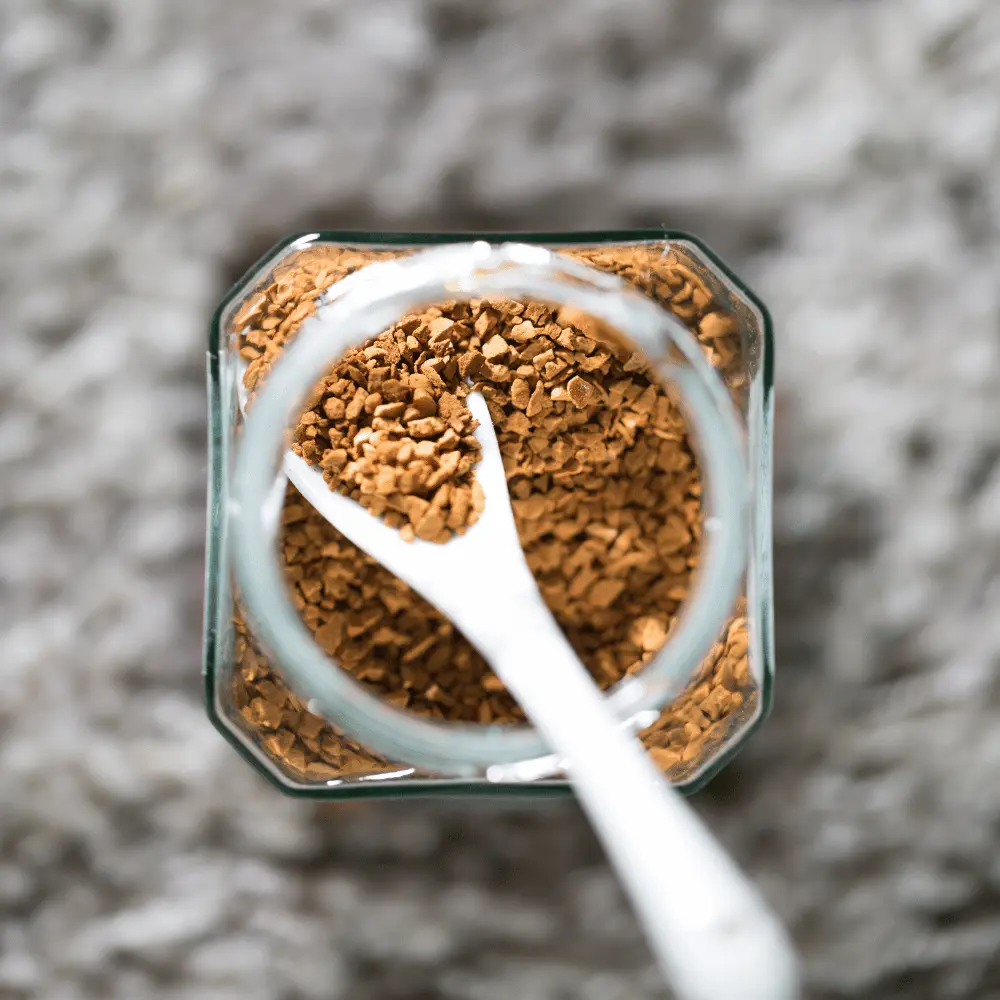
To savor the utmost quality of this coffee, adhere to the ensuing guidelines for proper preparation and storage:
- Preparation: A cup of this coffee can be brewed by simply adding the recommended quantity of coffee granules to a cup, pouring in hot water, and stirring until the complete dissolution of coffee granules. To personalize the coffee’s concentration, adjust the quantity of water and coffee. In case a creamier texture is preferred, try adding milk, cream, or a preferred dairy alternative.
- Storage: To maintain the freshness and flavor of this instant coffee, preserve it in an airtight container in a cool, dry area, away from direct sunlight and strong odors. To prevent any undesirable effect on coffee quality from moisture, be sure to reseal the packaging after every use.
- Shelf life: Despite this coffee’s prolonged shelf life, it is recommended to inspect the expiration date mentioned on the packaging to ensure the best possible flavor and aroma.
Creative Recipes and Ideas for Using Freeze Dried Coffee

This beverage can be a creative ingredient in various recipes and ideas, expanding beyond just a simple hot cup of coffee. Here are some suggestions to explore:
- Cold brew: For a refreshing and silky cold brew coffee, mix this coffee with cold water and refrigerate for a few hours.
- Coffee smoothie: Give your favorite smoothie recipe a caffeine boost by adding this instant coffee, which provides a flavorful and invigorating twist.
- Baking: Introduce a rich coffee flavor to baked goods, such as cakes, brownies, or cookies, by incorporating this coffee into the recipe.
- Coffee ice cream: Mix this beverage with a basic ice cream base and churn to create a homemade coffee ice cream that’s creamy and indulgent.
- Coffee cocktails: Experiment with this coffee drink to make coffee-infused cocktails, like espresso martinis or coffee-flavored old-fashioned, that are sure to impress.
- Dalgona coffee: You can mix freeze-dried coffee vigorously with a bit of water to make dalgona coffee
Travel and Outdoor Adventures with Freeze Dried Coffee
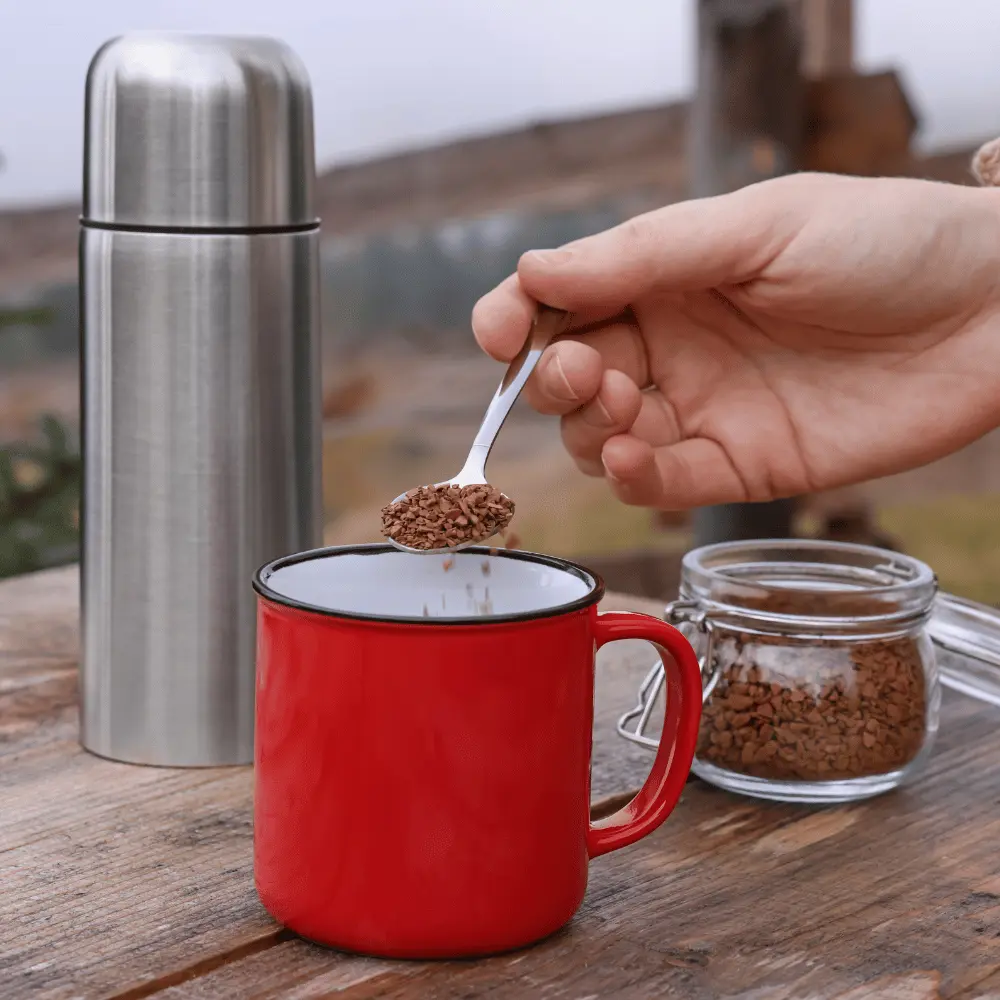
One of the most appealing characteristics of this type of coffee, as mentioned earlier, is its ease of portability, making it an ideal companion for outdoor activities and travel. Here are some tips for enjoying it while on the move:
- Camping and hiking: Pack a small container of this coffee in your backpack for a satisfying and comforting cup of coffee while camping or hiking. With hot water and a cup, you’re good to go.
- Road trips: Keep this instant coffee in your car for an instant caffeine boost during long road trips. Simply stop at a rest area or gas station for hot water to prepare your coffee.
- Flights: Take a small amount of this coffee in your carry-on luggage to enjoy a better quality coffee during your flight. Ask the flight attendant for hot water to mix with your coffee granules.
- Hotel stays: If you prefer a particular type of coffee, bring some of this coffee to enjoy in your hotel room instead of relying on the in-room coffee maker.
- Emergency kit: In case of power outages or other emergencies, including this coffee in your emergency kit for a comforting and energizing beverage.
By implementing these tips and tricks, this instant coffee can be enjoyed in various settings and situations, leveraging its convenience, versatility, and portability.
Conclusion
In summary, freeze dried coffee presents a distinct and expedient alternative to conventional coffee brewing methods, exhibiting several advantages, including its portability, ease of preparation, and prolonged shelf life. This comprehensive guide has offered comprehensive insights into the history and evolution of this coffee, its impact on flavor, the intricate freeze drying process, and its ecological implications. Moreover, we have examined how to select the most suitable brands and products, along with sharing tips and tricks for savoring this beverage in diverse circumstances.
While navigating the universe of this instant coffee, it is vital to contemplate aspects such as quality, flavor, sustainability, and cost to make a well-informed decision. Delve into the opportunity to experiment with varied brands, flavors, and innovative uses in your daily routine. By grasping the intricacies of this versatile beverage, you can indulge in a gratifying and environmentally conscious coffee experience that caters to your taste preferences and lifestyle.
FAQ
Does freeze dried coffee have less caffeine than regular coffee?
Generally, This instant coffee contains a similar caffeine content to regular coffee, although it may fluctuate based on the brand and coffee beans used. The caffeine level can also be influenced by the amount of coffee granules and water utilized during preparation.
Can freeze dried coffee be used in baking and cooking?
Indeed, this coffee can be utilized in baking and cooking, imparting a delectable coffee flavor to an array of recipes, including cookies, brownies, cakes, and even savory dishes.
Are there any health benefits or risks associated with consuming freeze dried coffee?
The health benefits and risks associated with this type of coffee consumption align with those of regular coffee. Moderate intake may provide advantages such as enhanced alertness and cognitive function, while excessive consumption can cause side effects like increased heart rate, anxiety, or digestive problems.















![Mount Hagen 3.53oz Organic Freeze Dried Instant Coffee - 6 pack | Eco-friendly Coffee Made From Organic Medium Roast Arabica Beans | Fair-Trade Coffee Instant [6 x 3.53oz Jar]](https://m.media-amazon.com/images/I/51n-+ZXtSrL._SL160_.jpg)
![Mount Hagen 3.53oz Organic Freeze Dried Instant Decaf Coffee- 6 Pack | Eco-friendly, Fair-Trade Decaffeinated Coffee Made From Organic Medium Roast Arabica Beans [6x 3.53oz Jar]](https://m.media-amazon.com/images/I/51LPHBRbJcL._SL160_.jpg)
![Mount Hagen 3.53oz Organic Freeze Dried Instant Decaf Coffee | Eco-friendly, Fair-Trade Decaffeinated Coffee, Made From Organic Medium Roast Arabica Beans [3.53oz Jar]](https://m.media-amazon.com/images/I/41qguVfbWyL._SL160_.jpg)
![Mount Hagen 3.53oz Organic Freeze Dried Instant Coffee | Eco-friendly, Fair-Trade Coffee Made From Organic Medium Roast Arabica Beans [3.53oz Jar]](https://m.media-amazon.com/images/I/41cv-2Z7XZL._SL160_.jpg)

